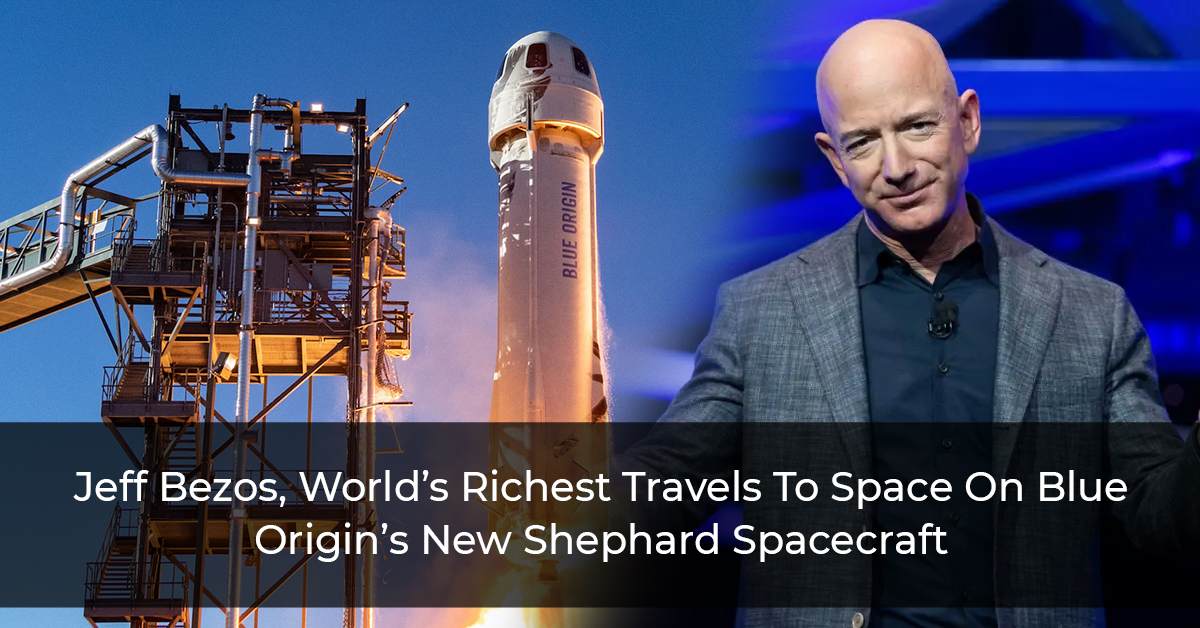Highlights:
- On July 20, Amazon CEO Jeff Bezos, who is also the world’s richest man, took a short voyage into space aboard a rocket flown by his aerospace company Blue Origin.
- “A very happy group of people in this capsule,” Jeff Bezos remarked after the spaceship landed in the west Texas desert after a 10-minute journey to the Karman line and returned.
On Tuesday, Jeff Bezos, the world’s richest man, spent a few minutes in space on Blue Origin’s first human journey, a landmark moment for a nascent industry attempting to make space accessible to the wealthy.
“This capsule has a very happy group of people,” Bezos remarked after the spaceship landed in the west Texas desert after a 10-minute journey to the Karman line and returned.
The four-person crew exchanged high-fives and hugs with family members who had waited to greet them at the landing site.
The New Shepard spacecraft had previously reached an altitude of 66.5 miles (107 kilometres), allowing occupants to feel weightless while studying the Earth’s arc.
“It’s dark up here,” remarked Wally Funk, a pioneering female aviator who accompanied Bezos, his brother, and 18-year-old Dutchman Oliver Daemen, who became the world’s youngest astronaut.
Virgin Galactic founder Richard Branson finished the mission on July 11, narrowly defeating Amazon founder Jeff Bezos in a battle of billionaires.
Blue Origin, on the other hand, had bigger goals, both in terms of the altitude to which its reusable New Shepard ship would ascend in comparison to Virgin’s spaceplane and in terms of its aims.
Bezos, who is 57 years old, launched Blue Origin in 2000 with the idea of one day creating floating space colonies with artificial gravity where millions of people will work and live.
Today, the business is working on a New Glenn heavy-lift orbital rocket as well as a Moon lander that it hopes to sell to NASA.
The New Shepard suborbital rocket, named after Alan Shepard, America’s first astronaut, had completed 15 unmanned flights to put it through its paces and evaluate safety features.
Also Read: India’s Covid Death Toll Could Be Close To 5 Million; Worst Human Tragedy Since Partition: Report
The launch was slightly delayed, and took place at 1312 GMT from Launch Site One, a remote location in the west Texas desert about 25 miles (40 kilometres) north of the nearest town, Van Horn.
“While it may have appeared simple today, it was anything but simple,” said Gary Lai, New Shepard’s principal designer.
The winner of a $28 million seat auction was obviously absent, owing to “scheduling concerns” and planning to travel on a later flight.
Daemen’s father, the CEO of a private equity firm, finished second in the auction, making his adolescent son the firm’s first paying customer.
Using a liquid hydrogen-liquid oxygen engine with just water vapour as a waste, New Shepard shot into orbit at speeds surpassing 2,300 mph (3700 kph).
The capsule detached from its launcher, and when it reached a safe altitude, the astronauts unbuckled and spent three to four minutes in space.
The launcher returned autonomously to a landing pad just north of its launch site, while the capsule landed gently on Earth using three enormous parachutes and a thruster.
Blue Origin has been coy about its plans for the future.
The company intends two additional flights this year and “many more” next year, according to the corporation.
Early accomplishments and establishing a solid safety record, according to analysts, will be important.
The next launch, according to CEO Bob Smith, might happen in September or October, and “willingness to pay continues to be pretty high.”
At the same time, the industry is coming under fire for the optics of super-wealthy people blasting off into space while Earth is dealing with climate-related crises and a coronavirus pandemic.
“Could there be a more inopportune time for two ultra-wealthy rocket owners to take a quick jaunt towards the dark?” writes Shannon Stirone in an Atlantic article “Space Billionaires, Please Read the Room.”


